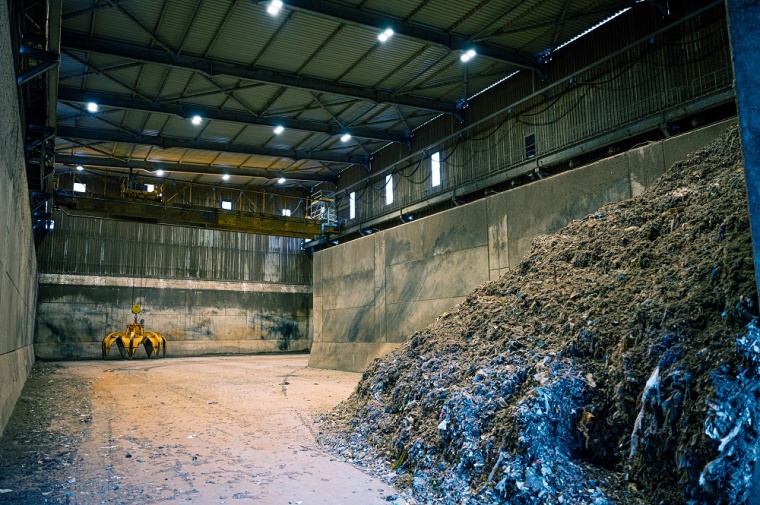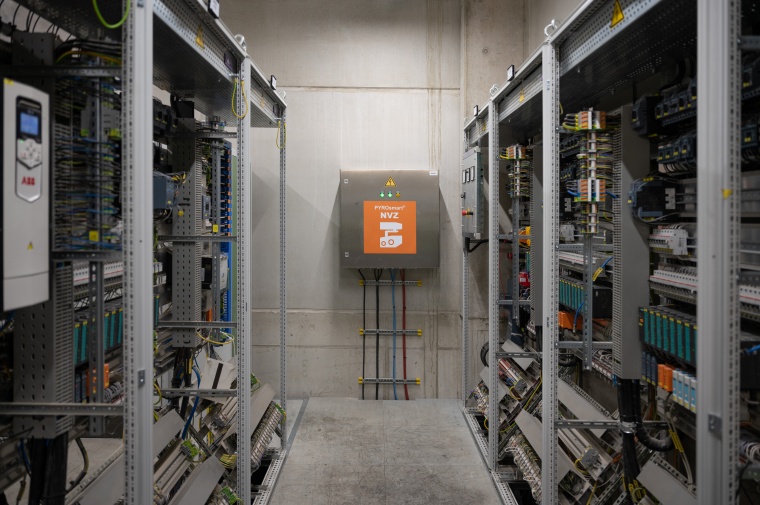Smart Fire Monitoring in Cement Production
Clinker production requires extremely high temperatures. Fuels therefore need to be kept at the ready to provide the necessary energy. However, whatever burns during a manufacturing process is also a fire hazard. The Heidelberg Materials cement plant in Schelklingen, Baden-Württemberg, Germany therefore uses infrared thermal imaging cameras to enable smart early fire detection.




Temperatures in rotary kilns during clinker production reach 1,450 degrees Celsius. Clinker is an industrially manufactured mixed stone made of burnt, deacidified limestone, clay and sand, and as a binding agent is the main component in cement. Primary fuels such as coal are typically used in the firing process. This is partly the reason for the high carbon footprint of the global cement industry, accounting for up to 8 % of the world‘s carbon dioxide emissions. To reduce the amount of primary fuels and thus also carbon dioxide emissions in clinker production, cement manufacturers have been switching to alternative fuels over recent decades. Old car tires were used for a long time, also for the firing process in the Schelklingen plant of Heidelberg Materials. In recent years, other fuels have begun to be utilized. In Schelklingen, for example, derived fuels and wood recycling (BGS) are used in accordance with commercial and municipal waste processing specifications. Around two-thirds of all fuel used by Heidelberg Materials in Germany is now refuse-derived fuels.
However, this brings the problem of biomass from food scraps in packaging waste creating bacteria when left lying around for long periods of time. Heat is then generated in the decomposition process and, if undetected, spontaneous combustion may eventually occur. This puts personnel at risk as well as enabling fires to spread rapidly within the combustible materials and destroying entire facilities. For the cement manufacturer, the financial damage would be enormous. It is therefore vital that fires within the manufacturing process are prevented from the outset with targeted and rapid extinguishing in worst-case scenarios. Practical and easy solutions are often not possible in large factory buildings due to the dusty and difficult environments. To optimally meet requirements within their cement plant, Heidelberg Materials therefore uses PYROsmart series infrared-based early fire detection systems from Orglmeister Infrarot-Systeme GmbH & Co. KG based in Walluf near Wiesbaden, Germany.
Panoramic Thermal Imaging Using Infrared and Video
Orglmeister‘s patented process in its PYROsmart products combines infrared thermal imaging and video technology to enable full monitoring of large factory areas that have adverse environments. In dusty and dirty factory premises, the conventional smoke aspiration systems typically found in industry can quickly fail. High-resolution infrared cameras use in-house abiroVision software to generate a panoramic thermal image that shows heat sources. Such infrared thermography is based on all objects emitting infrared waves depending on its temperature. Modern camera systems record these waves, from which they can calculate temperatures. The system is able to recognize spatial geometries and thereby precisely locate areas at risk. Pan/tilt technology also makes it possible to monitor very large areas. This is especially required in the cement plant‘s expansive fuel buildings.
Panoramic thermal imaging continuously delivers information to users in the cement plant‘s control center. Integrated compressed air cleaning keep the system‘s sensors clear to provide added safety. Heidelberg Materials has two threshold metrics: from 80 degrees Celsius a pre-warning is given, and from 90 degrees Celsius a fire alarm is triggered and fuel supplies to the kiln are cut off. However, not all measured “hotspots” are a risk to production. For example, exhaust systems on wheel loaders and trucks also produce heat that is non-critical to safety. Heidelberg Materials therefore got the PYROsmart software to teach itself. In an automatic learning phase, the new system ran in parallel with the existing fire alarm system and used smart interference detection to monitor the environment. It was able to learn whether a vehicle with a hot exhaust or engine was stationary or moving. These can now be automatically detected and classified as non-hazardous, and false alarms that would otherwise result in considerable financial and human effort are prevented.
Long-Term Partnership
Heidelberg Materials has been working with Orglmeister and the PYROsmart system for many years. The system was already operational in 2010 when the cement plant used car tires as fuel. A switch to other substitute fuels in 2018 required new plant construction and installation of PYROsmart FS. The FS series is aimed at applications monitoring large areas, while its sister system PYROsmart NS is primarily used for smaller spaces and conveyor belt monitoring. The Schelklingen plant opted for the solution because of its excellent experience with PYROsmart. “Orglmeister won us over with the operability and technology of their products. Stability plus pan/tilt technology. You get it all in one system,” explains Christian Haupt, head of electrical and automation engineering at the plant.
He also appreciates the fast spare parts service and the good relations he always has with Orglmeister personnel. Reliable monitoring has been provided by PYROsmart since its installation. “We‘re delighted with it, and it works,” Haupt says. After switching to substitute fuels, the new fuel building was equipped with the early fire detection system, which uses several cameras to monitor the fuel. Orglmeister has equipped the boxes and push floors for material delivery in another fuel building, as well as the entire premises. The building cannot be entered during operation, and processing with a gantry crane is fully automatic. An automatic extinguishing system is therefore installed there to prevent fires from even starting. Working together with Austrian partner company Rosenbauer, a fire-monitor extinguisher has been installed, which the PYROsmart system operates to perform targeted and automated extinguishing when hotspots are detected.
Fortunately, the system has not yet had to act. “If there’s a fire, it‘s almost already too late,” says plant manager Michael Cypra. Between detection and intervention by firefighters, the whole building can be on fire within just a few minutes. The combined PYROsmart and fire monitor system can detect and automatically extinguish a fire at a very early stage in its development. Costly operational failures and fire damage can then be prevented. Manual operation of the extinguishing system is also an option. Heidelberg Materials therefore also manages extinguishing activities via the company’s in-house control center, which can access PYROsmart data.
If a fire breaks out, the control center can then decide how to proceed. This is vital because firefighters need to be directed across the large plant complex. For this reason, regular firefighting drills are held. Staff can also permanently monitor situations within buildings from a distance. When an alarm is triggered, the system informs those responsible in the control center to enable action to be taken quickly.
In Use at Other Plants
A total of five PYROsmart systems and one fire-monitor extinguisher have been installed in the Schelklingen plant to ensure safe cement production and safer working environments for staff. Heidelberg Materials operates eight cement plants and two milling plants throughout Germany, with the Schelklingen site in Baden-Württemberg being one of the largest. “We of course keep in close contact with each other,” says plant manager Michael Cypra. Heidelberg Materials has found a solution in PYROsmart that is now also being used at many European locations. Because of its broad applicability, it can be used flexibly and also tailored to the specific needs of the cement industry.
Europe-Wide Early Fire Detection in Cement Plants
The project at Heidelberg Materials’ Schelklingen plant is just one of many that Orglmeister has completed throughout Europe in its long working relationship with the cement manufacturer. As well as the solution in Baden-Württemberg, four PYROsmart cameras and an extinguishing system have also been installed at the company’s plant in Triefenstein in Lower Franconia, while a PYROsmart system and extinguisher system are monitoring the premises in Burglengenfeld. At the French sites in Couvrot and Bussac-Forêt, two PYROsmart cameras with two extinguishing systems each are providing smart early fire detection. And in Devnya, Bulgaria, Orglmeister and Heidelberg Materials have also implemented four PYROsmart units and an extinguishing system.


Business Partner
Orglmeister Infrarot SystemeAm Klingenweg 13
65396 Walluf
Germany
most read

Security management, building security & perimeter protection: the winners of category E at the GIT SECURITY AWARD 2026
GIT SECURITY AWARD 2026: Security management, building security & perimeter protection - an overview of the most innovative solutions


The Benefits of AI-based Video Surveillance Solutions for Sports Venues
Dallmeier Interview: Artificial intelligence Makes Stadiums Smarter

Is Your Venue Ready for Martyn’s Law?
Martyn’s Law demands stronger security by 2027. Is your venue prepared to protect and respond?

Integrated and Futureproof: Traka’s Next Chapter
Interview with Stefni Oliver on Traka’s Vision for the Future







